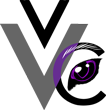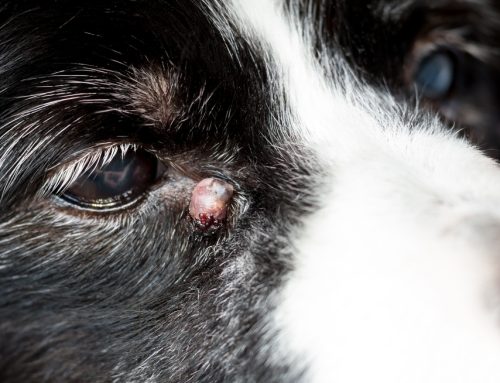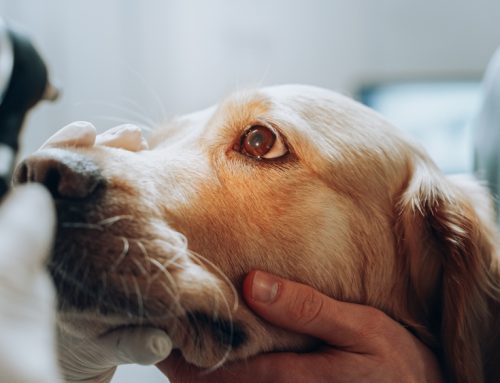The most common eyelid abnormality in dogs is called entropion, which is a frequent primary cause of tearing, squinting, and eye ulcers in young puppies. Entropion also occurs in older dogs, but is usually secondary to another underlying disease process. Treatment options for all dogs are similar. Veterinary Vision Center team members are entropion experts, so we’re answering the most frequently asked questions to ensure pet owners understand their dog’s condition and treatment options.
Question: What is entropion in dogs?
Answer: Entropion is the medical term for eyelids that roll inward and cause eyelashes to rub on the cornea. Most often, the lower eyelid and outer eye corner are affected in one or both eyes. Some dogs—usually large breeds or those with excessive facial skin—have entropion in all four eyelids.
Q: What causes entropion in dogs?
A: Entropion can be primary, secondary, or temporary. Dogs with primary entropion are born with the condition, while those with secondary entropion acquire the problem later in life. Spastic (i.e., temporary) entropion is a temporary inward roll caused by extreme squinting because of a painful eye condition. Once the dog is comfortable again and stops squinting, the eyelids return to normal. These dogs may have mild primary entropion that is only evident during squinting.
Primary entropion usually results from a combination of genetic and breed-related factors that determine head shape, eye socket depth, eyelid length, and excessive skin or skin folds around the eyes. Secondary entropion can follow eye or eyelid trauma or scarring, skin conditions affecting the eyelids, and skull muscle or fat loss that causes the eye to sink deeper into the socket.
Q: Which dog breeds are prone to entropion?
A: Any dog can develop entropion, but some breeds with the above factors are at greater risk. Breeds prone to entropion include:
- Large and giant breeds—Saint Bernard, bullmastiff, Great Dane, bloodhound
- Working breeds—Labrador retriever, golden retriever, poodle, Irish setter
- Wrinkled breeds—Chow chow, pug, shar pei, English bulldog
Q: What are entropion signs in dogs?
A: Entropion signs can be vague and similar to many other eye conditions. Signs include:
- Watery or mucoid discharge
- Eye rubbing
- Eye redness
- Squinting
Entropion is uncomfortable, and can lead to corneal ulcers and vision-impairing inflammation or scarring if left untreated.
Q: How is entropion in dogs diagnosed?
A: Your primary veterinarian can diagnose entropion by observing the eyelids rolling inward, and may refer you to a veterinary ophthalmologist for treatment. A veterinary ophthalmologist can examine the eyes in greater detail to rule out other common eyelid conditions, such as ectopic cilia (i.e., abnormal eyelashes), or distichia (i.e., extra eyelashes), that may also be causing your dog discomfort.
Q: Can dogs outgrow entropion?
A: Every once in a while, a puppy may have a transient entropion that results from uneven facial development, but this is the exception. Most puppies with entropion will eventually require treatment. Older dogs who acquire entropion later in life also cannot outgrow their condition.
Q: How are puppies treated for entropion?
A: For most puppies with entropion, the veterinarian will pursue permanent correction with reconstructive eyelid surgery, but this cannot be performed until puppies are close to their full adult size. Because entropion can damage the cornea and cause long-term scarring, puppies usually need a temporary, reversible procedure to provide relief until their permanent surgery. A veterinary ophthalmologist will decide which procedure is best for each dog, with options including:
- Eyelid tacking — This procedure involves placing sutures or staples that pull the eyelid tissue away from the corneal surface. These can be left in for several weeks.
- Eyelid filler injections — Hyaluronic acid filler, a well-tolerated ingredient often used to fill human wrinkles, can be injected into the eyelids to puff them up so the eyelashes roll away from the cornea. The filler lasts around six to 18 months.
Q: How are adult dogs treated for entropion?

A: Older puppies and adult dogs need surgery to permanently correct their eyelid positioning. The surgery removes excess skin and tightens the lids so they no longer roll inward. Some pugs and bulldogs need additional surgery to permanently narrow the eyelid openings, and some large breeds with excess eyebrow skin need a brow lift. Your primary veterinarian may be comfortable performing a simple lower lid entropion surgery, but more complex procedures are best left to a veterinary ophthalmologist.
Q: Should I breed a dog with entropion?
A: While the genetic basis is not fully understood, entropion is thought to be a heritable condition that can be passed to future generations, so dogs with entropion should not be used in a breeding program.
The experienced Veterinary Vision Center team can diagnose entropion and find the right treatment option for your puppy or adult dog. Entropion signs can mimic many other eye diseases and conditions, so an ophthalmologic examination is important to obtain the proper diagnosis. Contact us to schedule a consultation if you have any concerns about your dog’s eye health.







Leave A Comment